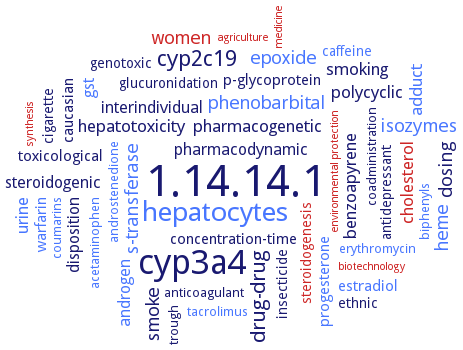1.14.14.1: unspecific monooxygenase
This is an abbreviated version!
For detailed information about unspecific monooxygenase, go to the full flat file.

Word Map on EC 1.14.14.1 
-
1.14.14.1
-
cyp3a4
-
hepatocytes
-
cyp2c19
-
drug-drug
-
epoxide
-
phenobarbital
-
dosing
-
women
-
smoke
-
heme
-
s-transferase
-
isozymes
-
cholesterol
-
hepatotoxicity
-
smoking
-
polycyclic
-
adduct
-
benzoapyrene
-
urine
-
pharmacogenetic
-
steroidogenic
-
disposition
-
androgen
-
interindividual
-
pharmacodynamic
-
gst
-
warfarin
-
toxicological
-
concentration-time
-
progesterone
-
p-glycoprotein
-
caucasian
-
estradiol
-
genotoxic
-
ethnic
-
antidepressant
-
steroidogenesis
-
insecticide
-
cigarette
-
caffeine
-
glucuronidation
-
coadministration
-
androstenedione
-
anticoagulant
-
trough
-
coumarins
-
acetaminophen
-
biphenyls
-
tacrolimus
-
erythromycin
-
synthesis
-
biotechnology
-
medicine
-
environmental protection
-
agriculture
- 1.14.14.1
- cyp3a4
- hepatocytes
- cyp2c19
-
drug-drug
- epoxide
- phenobarbital
-
dosing
- women
-
smoke
- heme
- s-transferase
- isozymes
- cholesterol
-
hepatotoxicity
-
smoking
-
polycyclic
- adduct
-
benzoapyrene
- urine
-
pharmacogenetic
-
steroidogenic
-
disposition
- androgen
-
interindividual
-
pharmacodynamic
- gst
- warfarin
-
toxicological
-
concentration-time
- progesterone
- p-glycoprotein
-
caucasian
- estradiol
-
genotoxic
-
ethnic
-
antidepressant
- steroidogenesis
-
insecticide
-
cigarette
- caffeine
-
glucuronidation
-
coadministration
- androstenedione
-
anticoagulant
-
trough
- coumarins
- acetaminophen
- biphenyls
- tacrolimus
- erythromycin
- synthesis
- biotechnology
- medicine
- environmental protection
- agriculture
Reaction
Synonyms
3AH15, 6 beta-hydroxylase, 6-beta-testosterone hydroxylase, 7-alkoxycoumarin O-dealkylase, 7-ethoxycoumarin-O-deethylase, 7-ethoxyresorufin-O-deethylase, AA omega-hydroxylase, Aldehyde oxygenase, Arachidonic acid epoxygenase, aromatase, aryl hydrocarbon hydroxylase, aryl-4-monooxygenase, BG04_163, BM3, BPH, Brain aromatase, class IV cytochrome P450 monooxygenase, clavine oxidase, CLOA, Clone PF26, Clone PF3/46, Coumarin 7-hydroxylase, CP2D6, Cyp, CYP monooxygenase, CYP102, CYP102 monooxygenase, CYP1027H1, CYP102A1, CYP102A2, CYP102A3, CYP102A7, CYP102B1, CYP106, CYP107, CYP1074A2, CYP109, CYP116B3, CYP116B4, CYP116B46, CYP134, CYP150A20, CYP152, CYP154H1, CYP19, CYP197, CYP1A, CYP1A1, CYP1A2, CYP1A3, CYP1B1, CYP24A1, CYP27A1, CYP28A5, CYP2A3, CYP2A6, CYP2B, CYP2B4, CYP2B6, CYP2C11, CYP2C19, CYP2C8, CYP2C9, CYP2D6, CYP2E1, CYP305A1, CYP3A, CYP3A1, CYP3A4, CYP3A5, CYP3A7, CYP4, CYP4502F4, CYP4A, CYP4A4, CYP4A6, CYP4A7, CYP4AA1, CYP4E2, CYP4F, CYP4F2, CYP4F3A, CYP4F3B, CYP5035A2, CYP5035A3, CYP5035A5, CYP5035C1, CYP5036A1, CYP5036A3, CYP5037B2, CYP505D1, CYP505D2, CYP505D3, CYP505D4, CYP51, CYP512B5, CYP512H1, CYP5136A2, CYP5136A3, CYP5136A5, CYP5139A1, CYP5141A1, CYP5141D1, CYP5142A3, CYP5142C1, CYP5144A3, CYP5144A7, CYP5144A9, CYP5144C7, CYP5144D4, CYP5145A3, CYP5147A1, CYP5150B1, CYP53A15, CYP53C2, CYP53D2, CYP5A1, CYP63A2, CYP6B1, CYP6B1v1, CYP6B1V1/CYP6B1V2/ CYP6B1V3, CYP6B3V1/CYP6B3V2, CYP6B4V1/CYP6B4V2, CYP6B5V1, CYP714D1, CYP82E2, CYP82E3, CYP82E4v1, CYP82E4v2, CYP8A1, CYP9F2, CYPIA1, CYPIA2, CYPIA4, CYPIA5, CYPIB1, CYPIIA1, CYPIIA10, CYPIIA11, CYPIIA12, CYPIIA13, CYPIIA2, CYPIIA3, CYPIIA4, CYPIIA5, CYPIIA6, CYPIIA7, CYPIIA8, CYPIIA9, CYPIIB1, CYPIIB10, CYPIIB11, CYPIIB12, CYPIIB19, CYPIIB2, CYPIIB20, CYPIIB3, CYPIIB4, CYPIIB5, CYPIIB6, CYPIIB9, CYPIIC1, CYPIIC10, CYPIIC11, CYPIIC12, CYPIIC13, CYPIIC14, CYPIIC15, CYPIIC16, CYPIIC17, CYPIIC18, CYPIIC19, CYPIIC2, CYPIIC20, CYPIIC21, CYPIIC22, CYPIIC23, CYPIIC24, CYPIIC25, CYPIIC26, CYPIIC27, CYPIIC28, CYPIIC29, CYPIIC3, CYPIIC30, CYPIIC31, CYPIIC37, CYPIIC38, CYPIIC39, CYPIIC4, CYPIIC40, CYPIIC41, CYPIIC42, CYPIIC5, CYPIIC6, CYPIIC7, CYPIIC8, CYPIIC9, CYPIID1, CYPIID10, CYPIID11, CYPIID14, CYPIID15, CYPIID16, CYPIID17, CYPIID18, CYPIID19, CYPIID2, CYPIID3, CYPIID4, CYPIID5, CYPIID6, CYPIID9, CYPIIE1, CYPIIF1, CYPIIF3, CYPIIF4, CYPIIG1, CYPIIH1, CYPIIH2, CYPIIIA1, CYPIIIA10, CYPIIIA11, CYPIIIA12, CYPIIIA13, CYPIIIA14, CYPIIIA15, CYPIIIA16, CYPIIIA17, CYPIIIA18, CYPIIIA19, CYPIIIA2, CYPIIIA21, CYPIIIA24, CYPIIIA25, CYPIIIA27, CYPIIIA28, CYPIIIA29, CYPIIIA3, CYPIIIA30, CYPIIIA31, CYPIIIA5, CYPIIIA6, CYPIIIA7, CYPIIIA8, CYPIIIA9, CYPIIJ1, CYPIIJ2, CYPIIJ3, CYPIIJ5, CYPIIJ6, CYPIIK1, CYPIIK3, CYPIIK4, CYPIIL1, CYPIIM1, CYPIVA4, CYPIVA8, CYPIVB1, CYPIVC1, CYPIVF1, CYPIVF11, CYPIVF12, CYPIVF4, CYPIVF5, CYPIVF6, CYPIVF8, CYPVIA1, CYPVIB1, CYPVIB2, CYPVIB4, CYPVIB5, CYPVIB6, CYPVIB7, CYPXIX, CYPXIXA1, CYPXIXA2, CYPXIXA3, Cyt P450, cytochrome P-450 4 enzyme, cytochrome P-450 BM3, cytochrome P-450 monooxygenase, cytochrome P450 2B4, cytochrome P450 3A, cytochrome P450 3A4, cytochrome P450 aromatase, cytochrome P450 BM3, cytochrome P450 monooxygenase, cytochrome P450 monooxygenase 116B3, cytochrome P450 monooxygenase 2A6, cytochrome P450 monooxygenase 2C8, cytochrome P450 monooxygenase 2C9, cytochrome P450 monooxygenase 3A4, cytochrome P450 monooxygenase pc-2, cytochrome P450 monooxygenase pc-4, cytochrome P450 monooxygenase pc-5, cytochrome P450 monooxygenase pc-6, cytochrome P450 monooxygenase PC-foxy1, cytochrome P450 oxidoreductase, cytochrome P450 reductase, Cytochrome P450-D2, cytochrome P450-dependent monooxygenase, cytochrome P450-dependent monooxygenase 1A2, cytochrome P450-monooxygenase, cytochrome-P450 hydroxylase, DAH1, DAH2, Debrisoquine 4-hydroxylase, EC 1.14.1.1, EC 1.14.14.2, EC 1.14.99.8, EC 1.99.1.1, ECOD, Ema, EROD, Estrogen synthetase, EUI, fatty acid hydroxylase, flavocytochrome P450BM-3, flavoprotein monooxygenase, flavoprotein-linked monooxygenase, FMO3, FraEuI1c_1415, FraEuI1c_2494, FraEuI1c_5334, GA 16a,17-epoxidase, GA-deactivating enzyme, Hepatic cytochrome P-450MC1, HLp, HMPREF1624_01477, IIA3, Isozyme 3A, Laurate omega-1 hydroxylase, Lauric acid omega-6-hydroxylase, liver cytochrome P450-dependent monooxygenase, LMC1, Mephenytoin 4-hydroxylase, MFO, microsomal monooxygenase, microsomal P-450, mixed function oxygenase, monooxygenase 3, monooxygenase P450 BM-3, More, N-demethylase, nicotine oxidase, O-demethylase, OLF2, Olfactive, Os05g0482400 protein, Ovarian aromatase, oxygenase, flavoprotein-linked mono-, P(3)450, P-448, P-450 PHPAH1, P-450(M-1), P-450-MK2, P-450AROM, P-450IB, P-450IIIAM1, P-450MC, P-450MP, P-450UT, P1-88, P24, P450, P450 17-alpha, P450 19A1, P450 1A1, P450 1A2, P450 1B1, P450 2A6, P450 2B6, P450 2C19, P450 2C9, P450 2D-29/2D-35, P450 2D6, P450 2E1, P450 2J2, P450 3A4, P450 4A11, P450 4F2, P450 BM3, P450 CM3A-10, P450 DUT2, P450 FA, P450 FI, P450 form 3B, P450 form HP1, P450 HSM1, P450 HSM2, P450 HSM3, P450 HSM4, P450 IIB1, P450 IIC2, P450 LM4, P450 LM6, P450 LMC2, P450 MD, P450 monooxygenase, P450 MP-12/MP-20, P450 P49, P450 PB1, P450 PB4, P450 PBC1, P450 PBC2, P450 PBC3, P450 PBC4, P450 PCHP3, P450 PCHP7, P450 TCDDAA, P450 TCDDAHH, P450 type B2, P450 types B0 and B1, P450(I), P450-11A, P450-15-alpha, P450-15-COH, P450-16-alpha, P450-254C, P450-3C, P450-6B/29C, P450-A3, P450-AFB, P450-ALC, P450-BM3, P450-CMF1A, P450-CMF1B, P450-CMF2, P450-CMF3, P450-DB1, P450-DB2, P450-DB3, P450-DB4, P450-DB5, P450-HFLA, P450-HP, P450-IIA10, P450-IIA11, P450-IIA3.1, P450-IIA3.2, P450-IIA4, P450-KP1, P450-LM2, P450-MC1, P450-MC4, P450-MK1, P450-MKJ1, P450-MKMP13, P450-MKNF2, P450-NMB, P450-OLF1, P450-OLF3, P450-P1, P450-P2/P450-P3, P450-P3, P450-PB1 and P450-PB2, P450-PCN1, P450-PCN2, P450-PCN3, P450-PM4, P450-PP1, P450-PROS2, P4501A1, P450arom, P450cam, P450CB, P450CMEF, P450E, P450EF, P450F, P450H, P450I, P450IIC5, P450MT2, P450RAP, P450RLM6, P450s 3A, P450SMO, P52, PB15, PHP2, PHP3, PikC, PikC hydroxylase, Progesterone 21-hydroxylase, Prostaglandin omega-hydroxylase, PTF1, PTF2, S-mephenytoin 4-hydroxylase, Sam5, sertraline N-demethylase, SIAM614_30676, Steroid hormones 7-alpha-hydroxylase, Testosterone 15-alpha-hydroxylase, Testosterone 16-alpha hydroxylase, Testosterone 6-beta-hydroxylase, Testosterone 7-alpha-hydroxylase, xenobiotic monooxygenase


 results (
results ( results (
results ( top
top





